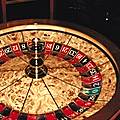- By New York State Comptroller's Office
- Business & Technology
 Print
Print  As policymakers consider possible expansion of revenue streams from gaming, New York State Comptroller Thomas P. DiNapoli released a report today on the industry in the state that calls for improvements in finding an appropriate balance between reliance on revenue generated from gaming activities and problem gambling.
As policymakers consider possible expansion of revenue streams from gaming, New York State Comptroller Thomas P. DiNapoli released a report today on the industry in the state that calls for improvements in finding an appropriate balance between reliance on revenue generated from gaming activities and problem gambling."The lottery generates billions of dollars each year for New York," DiNapoli said. "While numbers are down this year due to the coronavirus pandemic, the Gaming Commission is studying ways to boost revenues going forward. Before expanding gambling, the state must take a closer look at the impacts of casinos and other gaming already in place, as well as the problem of compulsive gambling."
Revenue Picture
New York collects more gaming revenue than any other state, totaling nearly $3.7 billion in State Fiscal Year (SFY) 2019-20. The state generates revenue for its budget and for localities through traditional lottery games, video lottery terminals (VLTs), racetrack wagering, casinos, sports betting and other authorized activities.
Traditional lottery games remain the dominant contributor to gaming revenues, providing two-thirds of total gaming receipts in SFY 2019-20. They generated $2.5 billion while VLTs, which are legally part of the lottery, added $944 million.
DiNapoli noted the COVID-19 pandemic has had a significant impact on gaming revenues. The Division of the Budget projects total gaming revenues will decline by $616 million this year, primarily because of mandatory closings of casinos and VLT facilities for six months starting in mid-March. While lottery games have been available without interruption, those revenues were also impacted by the pandemic. Through September 2020, lottery revenues totaled $958 million, a decline of nearly $132 million from the same period in 2019. Lottery revenues for the fiscal year are projected to decline by $293 million or 11.8 percent from the previous year.
The report found the state spent more than $90 million last fiscal year marketing the lottery. In addition to the lottery's marketing costs, VLT facilities reported marketing spending totaling nearly $182 million in SFY 2018-19, bringing combined marketing spending for state-sanctioned gaming activities to more than $272 million.
In 2013, voters approved an amendment to the State Constitution to authorize up to seven commercial casinos. Four have opened to date. Since opening, and before closures caused by the pandemic, casinos failed to meet their original financial projections. Overall, actual revenues have been about two-thirds of casino developers' initial projections and thus far economic benefits appear to be modest.
Spending to Market Gaming Far Outweighs Treatment for Gambling Problems
The state has taken some steps to prevent and address the problem of compulsive gambling. The Office of Addiction Services and Supports (OASAS) has engaged two contractors to analyze the prevalence of problem gambling among New Yorkers. The agency also launched a statewide media campaign to raise awareness of problem gambling, which disproportionately occurs among males, African Americans and adults who live in disadvantaged neighborhoods.
According to OASAS, state spending on prevention, treatment and recovery services related to problem gambling in SFY 2019-20 was expected to total $5.7 million. DiNapoli said these important measures are funded at levels significantly below the resources devoted to promoting gambling in the state. The report found that while expanding legalized gaming repeatedly over recent decades, the state has taken few, if any, steps to determine whether its efforts to maximize revenue may harm New Yorkers who are susceptible to compulsive gambling.
DiNapoli's office released an audit in 2019 examining efforts to treat problem gambling in New York and found not enough treatment programs were offered around the state and no comprehensive look had been done to assess the problem in communities. A follow up audit released in May found OASAS had taken steps to improve the issues identified by auditors.
Given the challenge of the state's interests in maximizing revenue and in avoiding harm to New Yorkers from problem gambling, DiNapoli recommended policymakers:
- Assess whether the state strikes an appropriate balance between the marketing resources devoted to increasing gambling activity and those devoted to preventing and treating problem gambling. As part of this, the Gaming Commission and OASAS should report annually on the levels of this spending;
- Require the Gaming Commission to report regularly on how actual casino revenues to the state and job numbers compare to original projections, and identifying the factors underlying any variance;
- Clearly identify the social and economic impacts of the lottery and other state-sanctioned gaming activities. Ongoing discussion of potential further gaming expansions should be informed by comprehensive, current information on social and economic impacts, as well as those related to revenue;
- Address problem gambling associated with all forms of gaming, including the lottery.
v16i45




